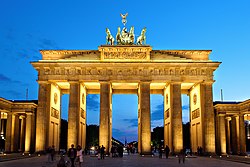Neoclassicism

Neoclassicism is the name given to movements in the arts that draw upon Western classical art and culture (usually that of Ancient Greece or Ancient Rome).[1] Traditionally, Classicism is about the art made in antiquity (very long ago, in ancient times) or later art inspired by that of antiquity.[1] But Neoclassicism is always about the art made later but inspired by antiquity.[1] So, Classicism and Neoclassicism are often used together. It often means clearness, elegance, harmony, and rest made by careful attention to traditional forms.
Examples of Neoclassicism in architecture include the White House and Neue Wache.
Neoclassicism Media
Johann Joachim Winckelmann, often called "the father of archaeology"
Hôtel Gouthière, Rue Pierre-Bullet no. 6, Paris, possibly by J. Métivier, 1780
"The Etruscan room", from Potsdam, Germany, c.1840, illustration by Friedrich Wilhelm Klose
Château de Malmaison, 1800, room for the Empress Joséphine, on the cusp between Directoire style and Empire style
Bonaparte Visiting the Plague Victims of Jaffa; by Antoine-Jean Gros; 1804; oil on canvas; 5.2 x 7.2 m; Louvre
Bust of Madame Récamier; by Joseph Chinard; 1805 or 1806; marble; 80 x 42 x 30 cm; Museum of Fine Arts of Lyon, France
Brandenburg Gate in Berlin (1788–1791) by Carl Gotthard Langhans
Related pages
References
- ↑ 1.0 1.1 1.2 "Classicism and Neoclassicism (arts) -- Britannica Online Encyclopedia". britannica.com. Retrieved 1 June 2010.
Other websites
 Media related to Neoclassicism at Wikimedia Commons
Media related to Neoclassicism at Wikimedia Commons- "Neoclassicism Style Guide". British Galleries. Victoria and Albert Museum. Archived from the original on 2012-08-03. Retrieved 2007-07-17.








